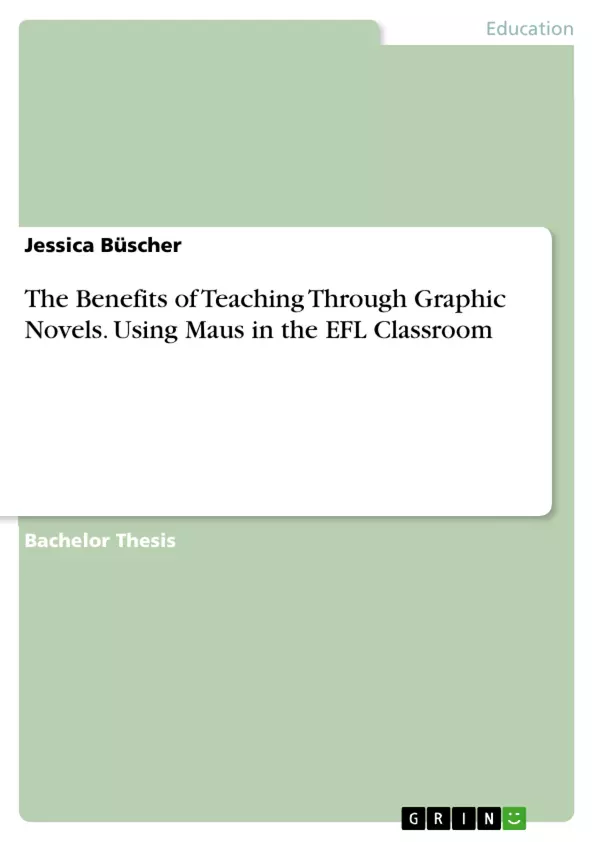In this paper, I will argue that the usage of the graphic novel "The Complete Maus" by Art Spiegelman is beneficial in the EFL classroom and will improve students' communicative competencies in learning English as a foreign language.
"Graphic novels let you take risks that just wouldn't fly in the conventional book form". This quote by the American professor Karin Slaughter proves that the genre of graphic novels is special and therefore needs more attention. Still, many people have prejudices and think of graphic novels as an embellished term for comics which shows that it is a controversial topic. However, graphic novels are way more than just picture books as they deal with complicated topics and storylines, developing characters and detailed drawings. Reading a graphic novel can be more difficult and challenging as a "usual" book as readers need to engage with the writing and the drawings and connect both in order to create meaning. The curriculum for the subject of English does not clearly state or suggest the usage of comics or graphic novels in the EFL classroom which is probably why the medium finds little to no space in the classroom. However, it's potential in the current competence-oriented curriculum is big as it can nurture the reading and writing competencies, the intercultural and lexical competencies as well as the training of a visual literacy which has never been so important as we are living in a visual world. That is why I will research how using graphic novels in general but also how using the specific graphic novel The Complete Maus by Art Spiegelman in the EFL classroom can improve student's communicative competencies. I picked this book as it is one of the most popular and powerful graphic novels. Spiegelman even received the Pulitzer Prize for his memoir of the Holocaust.
In the first part of this work I will focus on the theoretical background of graphic novels and their characteristics as this builds the foundation of this paper. Next, I will continue with the second part of the theoretical background by looking at the competencies of visual literacy and intercultural communicative competence as . In the next and main part of this paper, I will shortly analyze Maus and set my teaching goals before creating a concept for the EFL classroom. The concept will contain specific lesson plans with its material.
Inhaltsverzeichnis (Table of Contents)
- 1. Introduction
- 2. Comic Style Theory
- 2.1 Definition of Comics and Graphic Novels
- 2.2 Visual Language
- 2.3 Words and Text
- 2.4 Panel, Sequence and Page Layout
- 2.5 Text - Image – Relationship
- 3. Theoretical Background - Competencies
- 3.1 Visual Literacy
- 3.1.1 Definition
- 3.1.2 Teaching Visual Literacy
- 3.2 Intercultural Communicative Competence
- 3.2.1 Byram's model of ICC
- 3.2.2 Acquisition of ICC through Graphic Novels
- 4. The Complete Maus Analysis
- 4.1 Comic Style Analysis of The Complete Maus
- 4.2 Teaching goals using Maus
- 4.3 Concept for the classroom
- 4.3.1 Lesson 1: Introduction to the Book and Spiegelman's Style
- 4.3.2 Lesson 2: Review and Introduction to Artie and Vladek
- 4.3.3 Lesson 3: The Past and the Present
- 4.3.4 Lesson 4: Loss of Rights
- 4.3.6 Lesson 6: Juxtaposition of Vladek in Chapter 3+4
- Lesson 7: Mouse Holes
- Lesson 8-The Talk Show
- Lesson 9-Maus Review
- 5. Conclusion
- 5.1 Summary of Results
- 5.2 Final Consideration and Critical Appraisal of the Thesis
Zielsetzung und Themenschwerpunkte (Objectives and Key Themes)
The purpose of this paper is to explore the benefits of utilizing graphic novels, particularly "The Complete Maus" by Art Spiegelman, in the EFL classroom. This work aims to demonstrate how the use of this medium can enhance students' communicative competencies in learning English as a foreign language.
- The unique characteristics of graphic novels as a storytelling format and their potential in language learning.
- The importance of visual literacy in a visual world and its integration into EFL instruction.
- The development of intercultural communicative competence through engaging with diverse cultural perspectives presented in graphic novels.
- Specific teaching goals and lesson plans for using "The Complete Maus" to enhance reading, writing, and language skills.
- An analysis of the visual and narrative elements of "The Complete Maus" and their suitability for the EFL classroom.
Zusammenfassung der Kapitel (Chapter Summaries)
The first part of the paper focuses on the theoretical background of graphic novels, defining the medium and exploring its visual language, word usage, panel layout, and the relationship between text and images. The second part delves into the competencies of visual literacy and intercultural communicative competence, discussing the importance of each in the EFL classroom.
Chapter 4, the main part of the paper, offers a detailed analysis of "The Complete Maus," including its comic style and teaching goals for using it in the EFL classroom. This chapter also presents a specific concept for the classroom, outlining lesson plans with materials for each lesson. The lessons cover various themes and aspects of the graphic novel, focusing on developing student comprehension, critical thinking, and language skills.
Schlüsselwörter (Keywords)
This work explores the use of graphic novels, specifically "The Complete Maus" by Art Spiegelman, in EFL instruction. Key themes include visual literacy, intercultural communicative competence, narrative analysis, teaching goals, and lesson planning. The study aims to contribute to understanding the potential of graphic novels for enhancing communicative competencies in English as a foreign language.
- Quote paper
- Jessica Büscher (Author), 2020, The Benefits of Teaching Through Graphic Novels. Using Maus in the EFL Classroom, Munich, GRIN Verlag, https://www.grin.com/document/1490746



